SEO is the cherry on top of any digital marketing strategy as it provides you with the most tremendous global traffic possible.
Google serves trillions of users’ queries every month, so search engine optimization gives your business a brilliant opportunity to attract thousands of qualified visitors to the site. Thus, utilizing SEO must be one of your top marketing priorities.
I’ve put together this ultimate SEO checklist to help you get your website ranked in top positions.
Particularly, we’ll go through the following areas of a successful SEO strategy:
- Technical SEO checklist
- Keyword optimization checklist
- SEO content checklist
- On-page SEO checklist
- Off-page SEO checklist
Intro To The All-In-One SEO Checklist
If you’re new to SEO, you might want to check out our article on SEO requirements for website promotion with a detailed explanation of where to start.
However, if you’re not new to this topic and now want to check whether your website ticks all the necessary boxes, let’s go straight to this free SEO checklist.
I recommend you get back to this SEO checklist template:
- at least once;
- periodically;
- every time you publish a new page.
Make sure you cover every point listed below to please both search robots and your end users.
Let’s get started.
1. Technical SEO checklist
Technical SEO is aimed at improving a site’s technical state. For this, you’ll need to understand how to perform a site audit and create solid foundations in correspondence with the search algorithms.
It’s called ‘technical’ because it has nothing to do with the website content. Instead, you work with website and server internal optimizations, which will help search robots crawl and index your web pages better.
So let’s take a look at the best technical SEO practices.
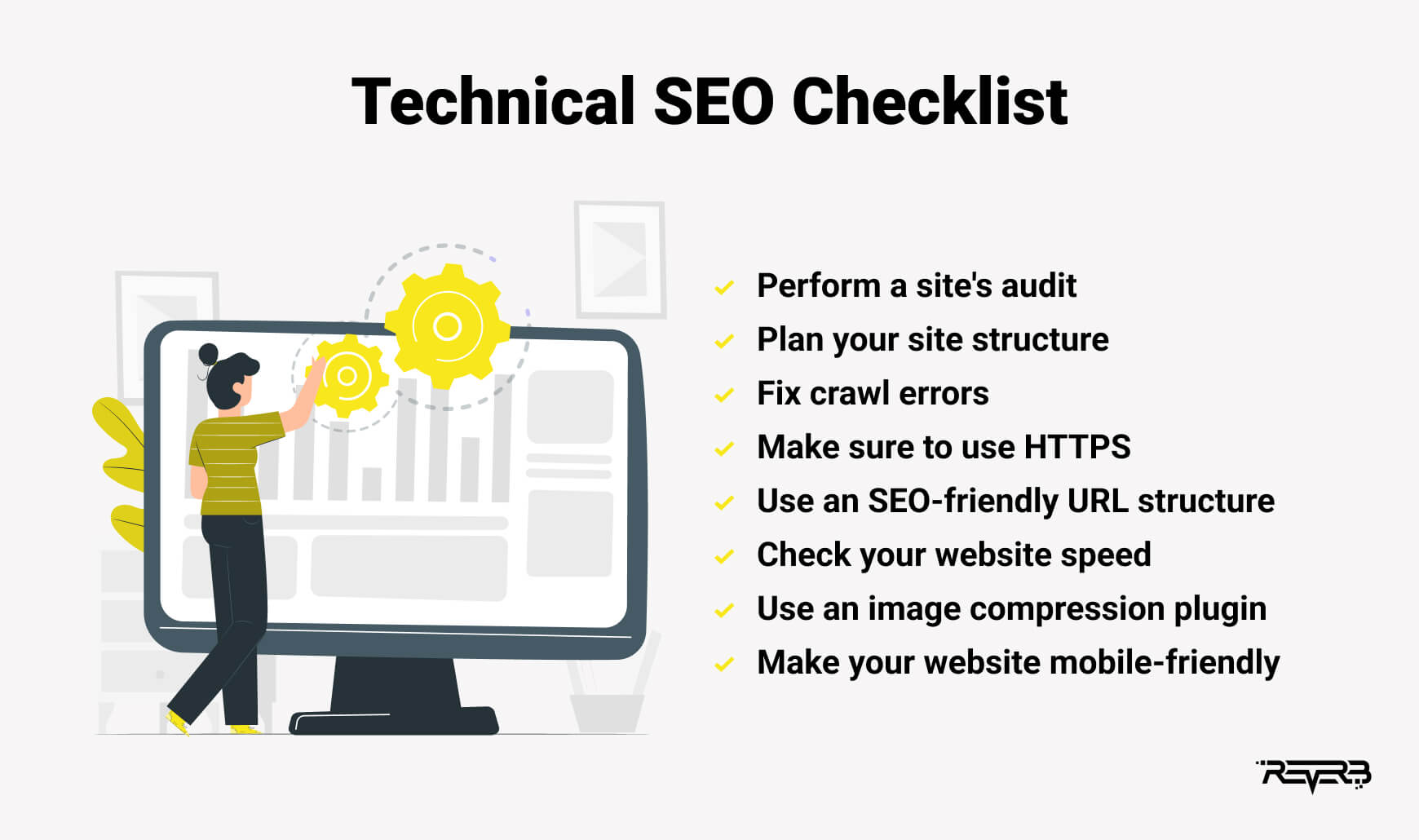
It’s essential for your website to be user-friendly. So, whether you’re in the process of creating a new site from scratch or planning a website redesign, you need to create a logical structure.
Not only will it help users to navigate your site easier, but it will also help to create internal links, which allow search spiders to crawl pages more effectively.
For Google to index your content, you have to ensure your website is crawlable on the whole. Google Search Console or specialized SEO tools such as Ahrefs, SemRush, SE Ranking can easily help you find any crawl errors.
Make sure you take time to fix any errors, including 404 errors, incorrectly canonicalized pages, and other types of problems that impact your site crawlability.

If you’re still using HTTP, it’s finally time to migrate. How can you confirm your website uses HTTPS? Just take a look at your browser’s URL bar. If a paddock is located on the left of the URL, you’re using HTTPS. If not, it’s time to switch.
HTTPS protects your visitors’ data and is a lightweight ranking factor that improves your website. All you need to do to switch to HTTPS is to buy and install an SSL Certificate.
- Use an SEO-friendly URL structure
An SEO-friendly URL structure allows the search engines to easily crawl your page and helps users to navigate easier.
Here are the top tips to reinforce your URLs:
- Include keywords
- Keep it short and descriptive
- Use hyphens to separate the words
- Don’t use underscores

Clicking on a website and waiting for it to load is frustrating. And honestly, nobody wants to experience it.
Once the page speed decreases, the probability of a bounce increases. That’s why I recommend regularly scanning your site with tools like GTMetrix or PageSpeed Insights and improving page speed if necessary.
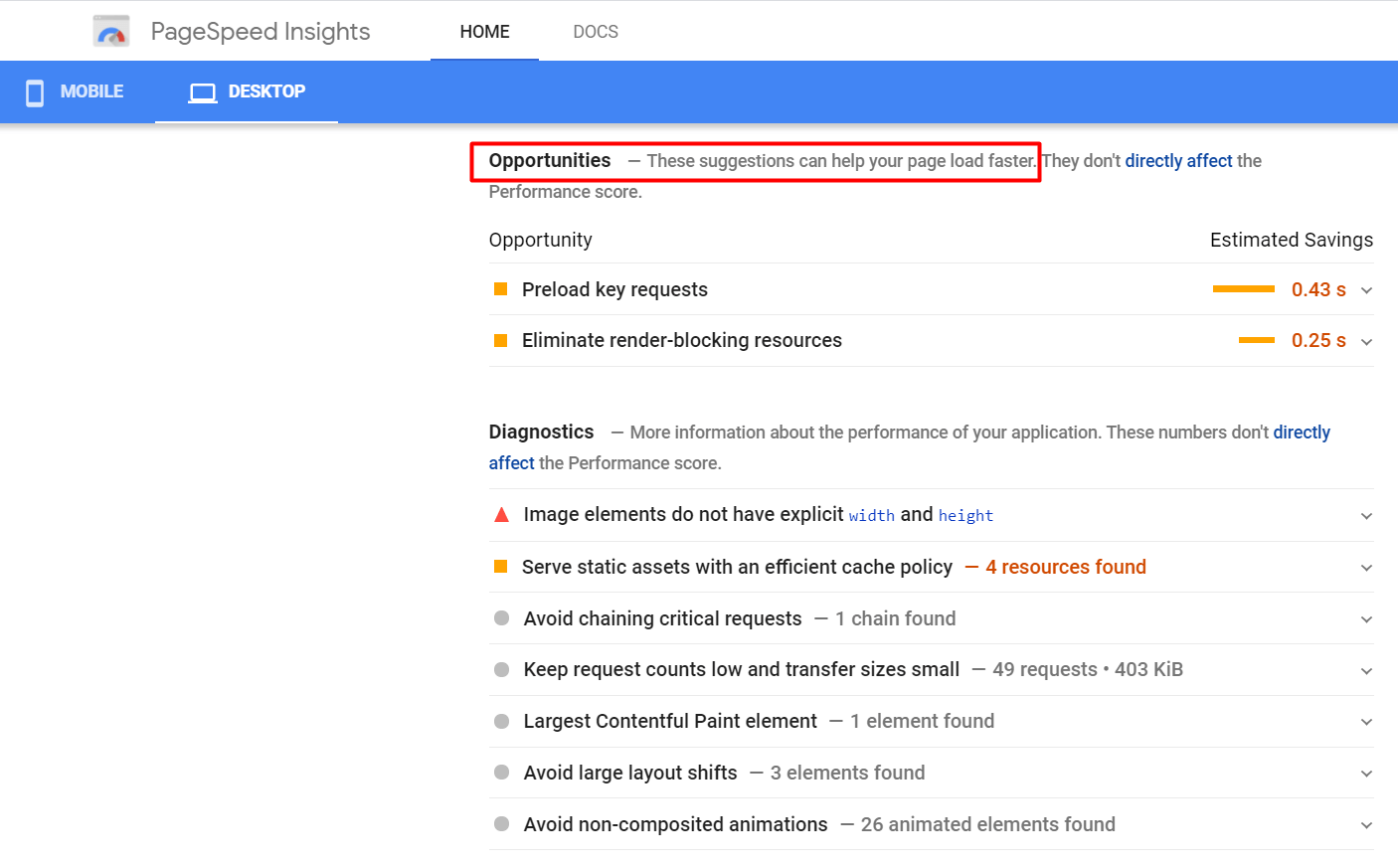
- Use an image compression plugin
In addition to the previous point, compressing images makes the files smaller, which improves page speed.
For this, you can use such tools as ILoveImg, TinyPNG, or ShortPixel.
- Make your website mobile-friendly
Most users browse using mobile devices, so it’s essential to ensure your site is mobile-friendly.
Google offers a Mobile-Friendly Test tool that will do all the work for you to ensure your website is ready to be used on any mobile phone or tablet.
2. Keyword optimization checklist
It’s important to ensure you’re using the quick-win keywords on your sales pages and blog posts to draw relevant traffic and potential customers to the site.
Here’s a website optimization checklist for selecting powerful keywords and optimizing web pages with them.
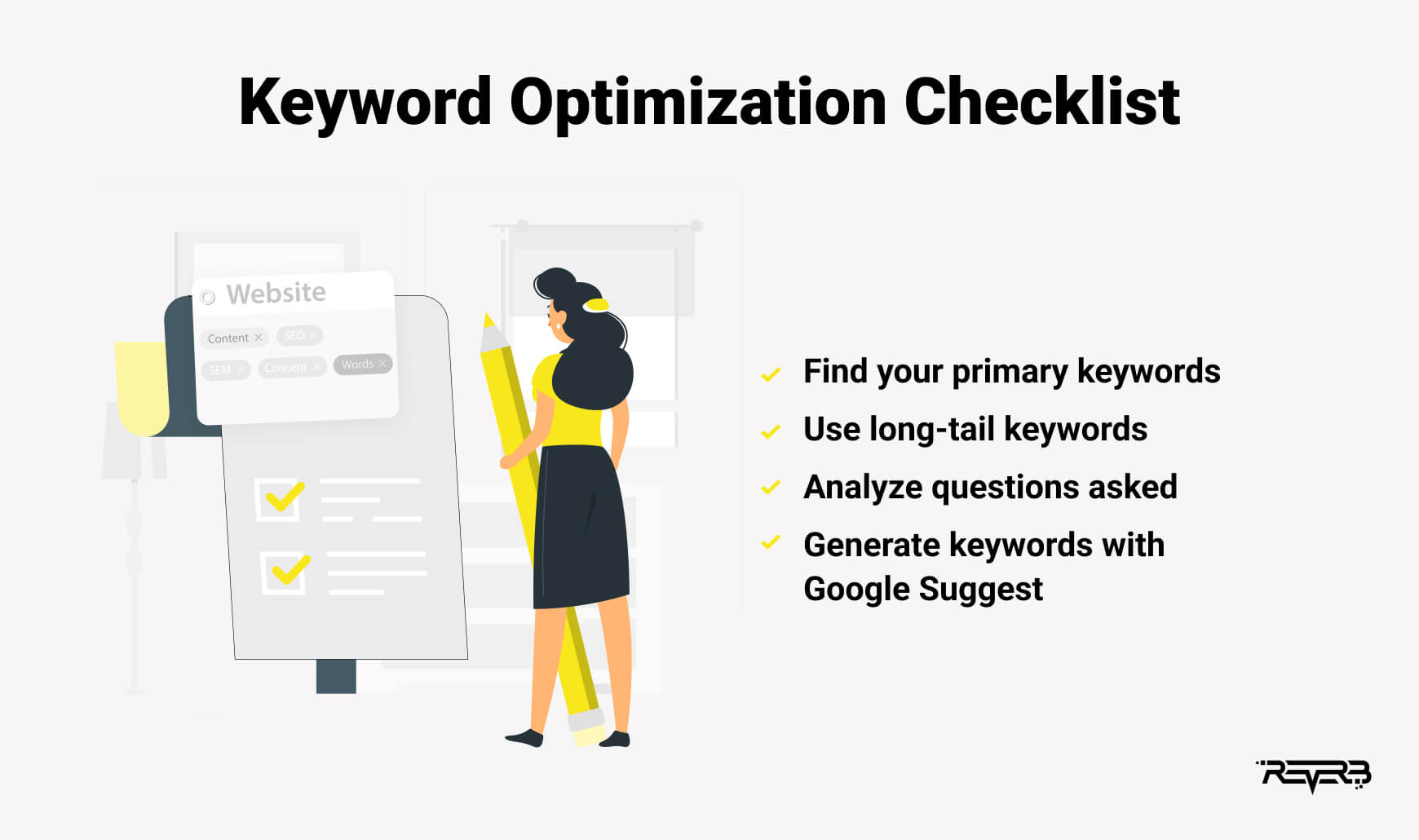
- Find your primary keywords
You need to find the main keyword for every important page that should drive your conversion, sales, and lead rates.
But how do you find the primary keyword? It should summarize your topic and have high search volume and accessible difficulty.
Analysis of your competitors’ keywords profile will help you identify those keywords.
Use the Keywords Explorer tool to view the characteristics of the selected keyword and generate more related terms.

Without long-tail keywords, your keyword strategy won’t work. Despite being lower volume than primary keywords, they are actually easier to rank for, thus, deliver a much higher conversion rate.
So, to succeed in your SEO game, you must include long-tail keywords along with your primary ones.
Once again, the Keywords Explorer would be useful for finding additional search suggestions. Just enter your primary keywords, choose the country you’re targeting, and the tool will offer you a list of long-tail keywords to choose from.

Knowing the questions people ask can help you better organize your content and make it more valuable to readers.
You can find the list of related questions for your keywords with the help of Keywords Explorer.
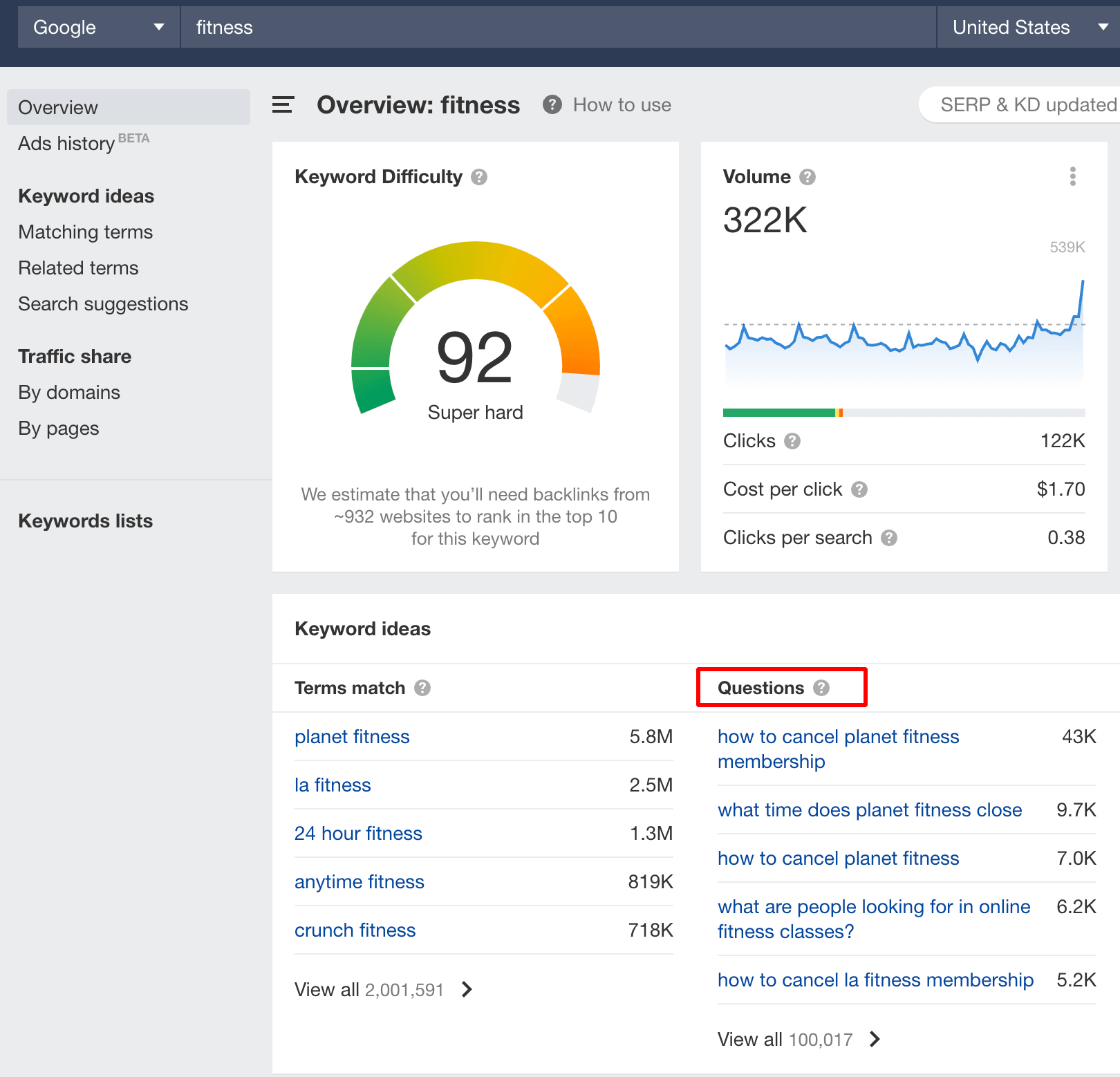
- Generate keywords with Google Suggest
Quality keyword research shouldn’t be expensive. You can use the Google Suggest tools to generate tons of high-quality target keywords within minutes. The best part of such a tool is that these suggestions are generated based on the queries from real people. So, Google points out the keywords users search for most frequently in the search tab and in the bottom of a SERP.
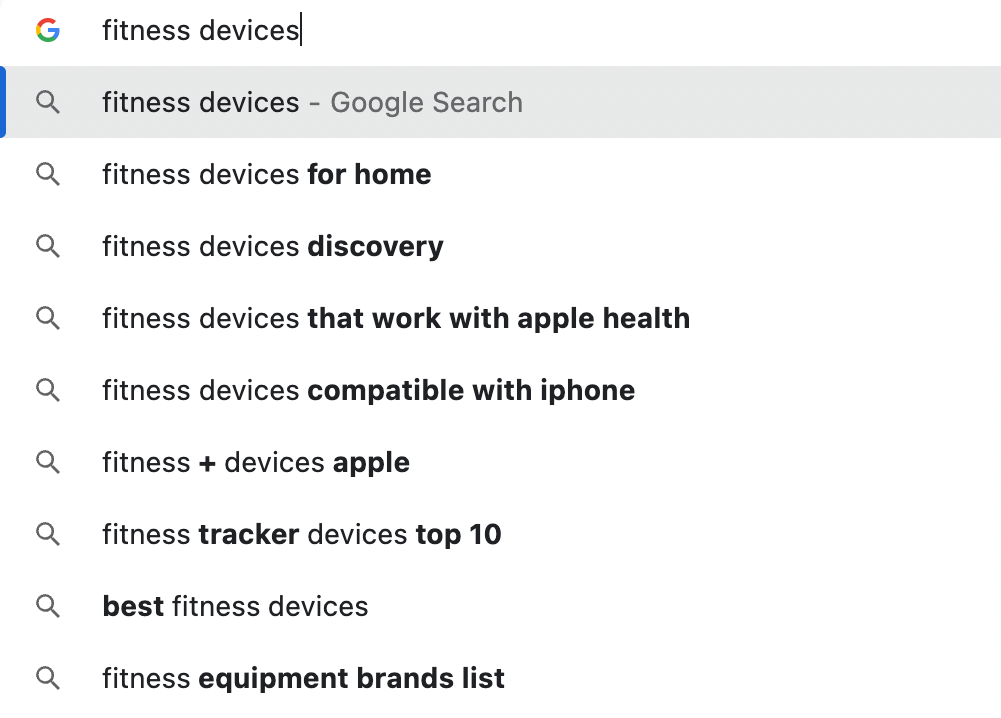
3. SEO content checklist
While keywords are one of the main SEO requirements for website optimization and essential factors for search robots, you also need to take no less care of the content quality.
Coming up with popular topic ideas, using engaging content formats, and writing high-quality articles are vital to please your audience. As a result, you’ll get high session duration and low bounce rate, which are also important for successful SEO.
Below I provide a batch of actionable tips for creating killer content.
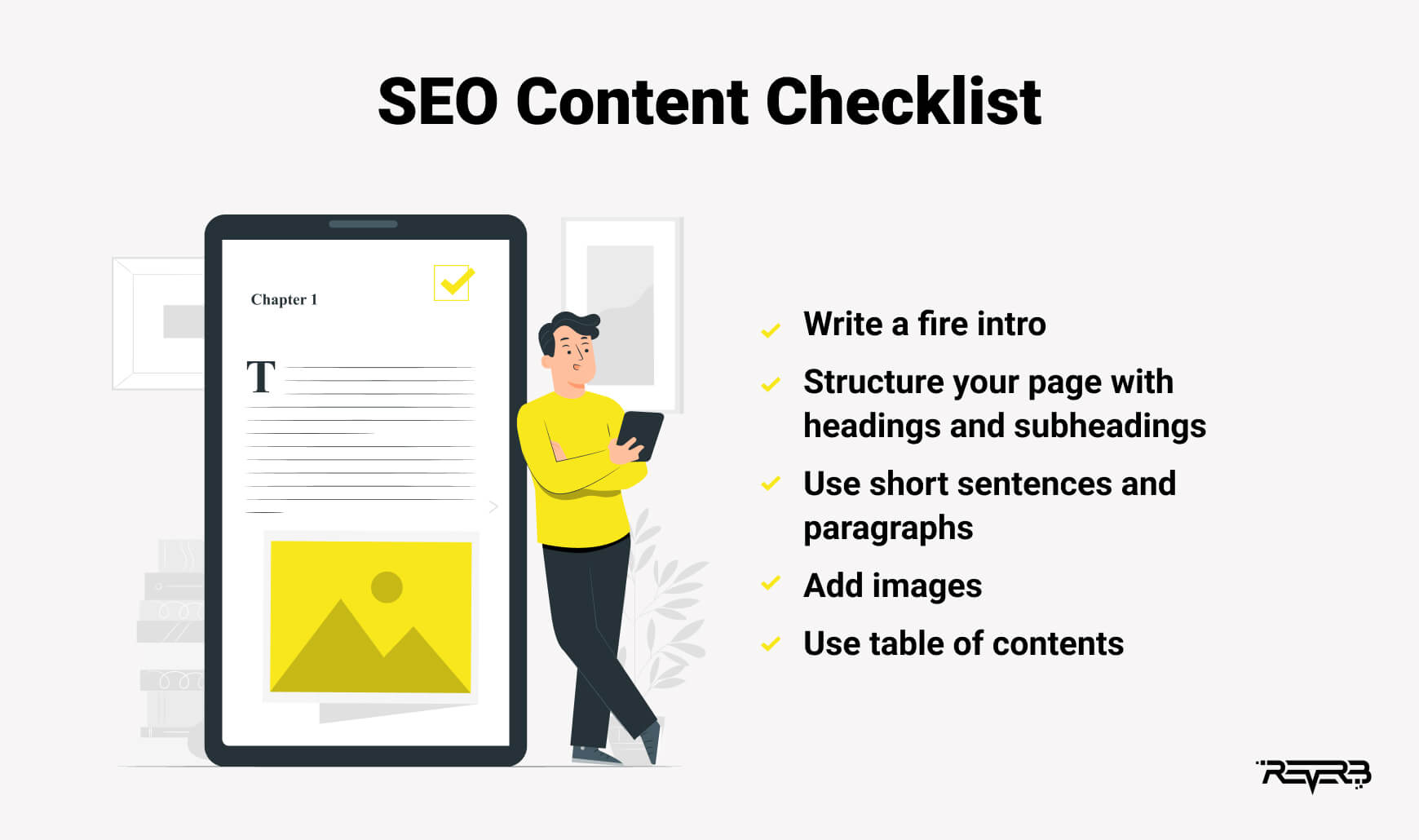
Remember that you must convince your readers they need to read your page to the end within the first few seconds before closing the tab.
So what should your intro include to grab the reader’s attention?
- Addressing some actual user problems on the topic
- A promise to solve this problem
Perform short research and see what people are searching for in order to solve their problems in your intro. Forums such as Quora or Reddit will give you some understanding of actual people’s concerns, needs, and challenges.

Remember that visitors won’t see the rest of the content if they don’t get past your introduction. So this is your only chance to make them stay.
- Structure your page with headings and subheadings
Headings and subheadings are essential parts of your website page as they allow you to break content into logical parts and simplify the user experience. Since most viewers tend to quickly scan the webpage instead of reading, strict structure helps them to digest the content and find the necessary information faster.
For instance, you may notice that our article is broken into several parts and subsections.
- Use short sentences and paragraphs
As I mentioned above, people prefer to scan texts. So don’t overcomplicate things and give the readers what they want.
Choose simple words, stick to short sentences, write in an active voice, and try to avoid jargon. Find more tips on how to write a content piece that engages and converts.
A big wall of text is overwhelming and, to be honest, boring. Images help break up your text and ease the user’s comprehension of your content.
What’s more, visual search is becoming popular, offering you an opportunity to attract more traffic from Google.
A table of contents allows users to jump from one part of your page to the desired section without endlessly scrolling. In addition, it makes your page rank on the Search Engine Result Page in a visually appealing format.
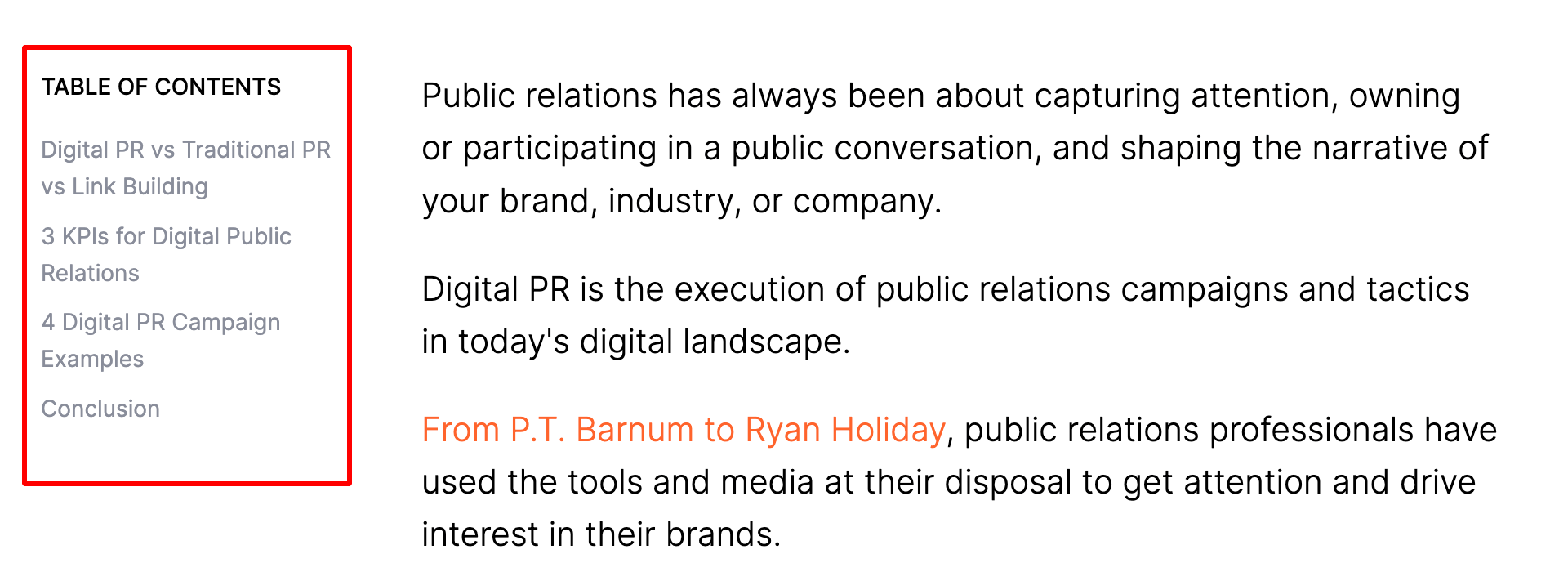
4. On-page SEO сhecklist
On-page SEO is another important part of the SEO audit checklist that helps optimize your web pages internally.
Particularly, you’ll need to work on the following aspects.
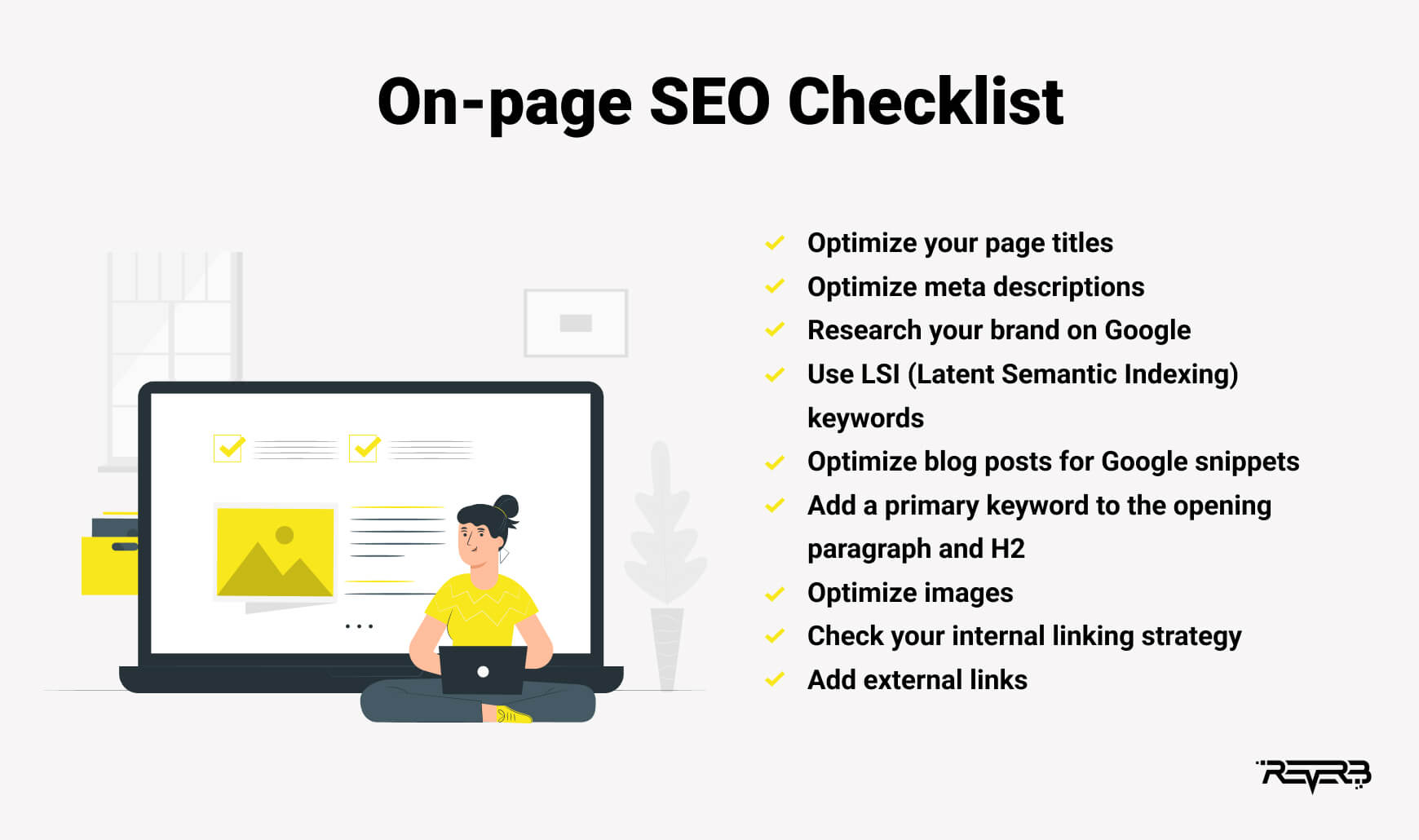
- Optimize your page titles
You have to ensure your title includes your primary keyword for search engines and users to better understand your page content.
Besides the title, you need to create a unique and engaging title tag. It will be shown in Google’s search results and influence whether people want to click on your page.
Here are a couple of additional reasons why a title tag matters:
- It’s the first thing a visitor sees when performing a search.
- People trust brands, so if your brand name is included in the title tag, people will likely click on it to get competent advice.

- Optimize meta descriptions
A meta description is responsible for a click-through rate and helps you get more search engine traffic. Your task is to create a short and sweet page summary to rekindle people’s interest.
These simple rules will help you write down a good meta description:
- Use an active voice.
- Keep it under 120 characters.
- Include your main keyword.

- Research your brand on Google
Perform a little research to see what results Google shows users when searching for your brand name. Make sure there are no negative reviews as they may impact your reputation and your SEO game.
- Use LSI (Latent Semantic Indexing) keywords
Ensure your webpage isn’t keyword-stuffed. Add LSI keywords or synonyms instead of using the same keyword too many times.
LSIGraph.com can help you with this creative task and give you a bunch of terms that go along with your target keywords.
- Optimize blog posts for Google snippets
You may have noticed that Google usually shows lists on top of the search results. Even if you Google “search engine optimization checklist,” you will most likely end up seeing a list of tips. So try to configure your posts in a way they are eligible for list snippets.
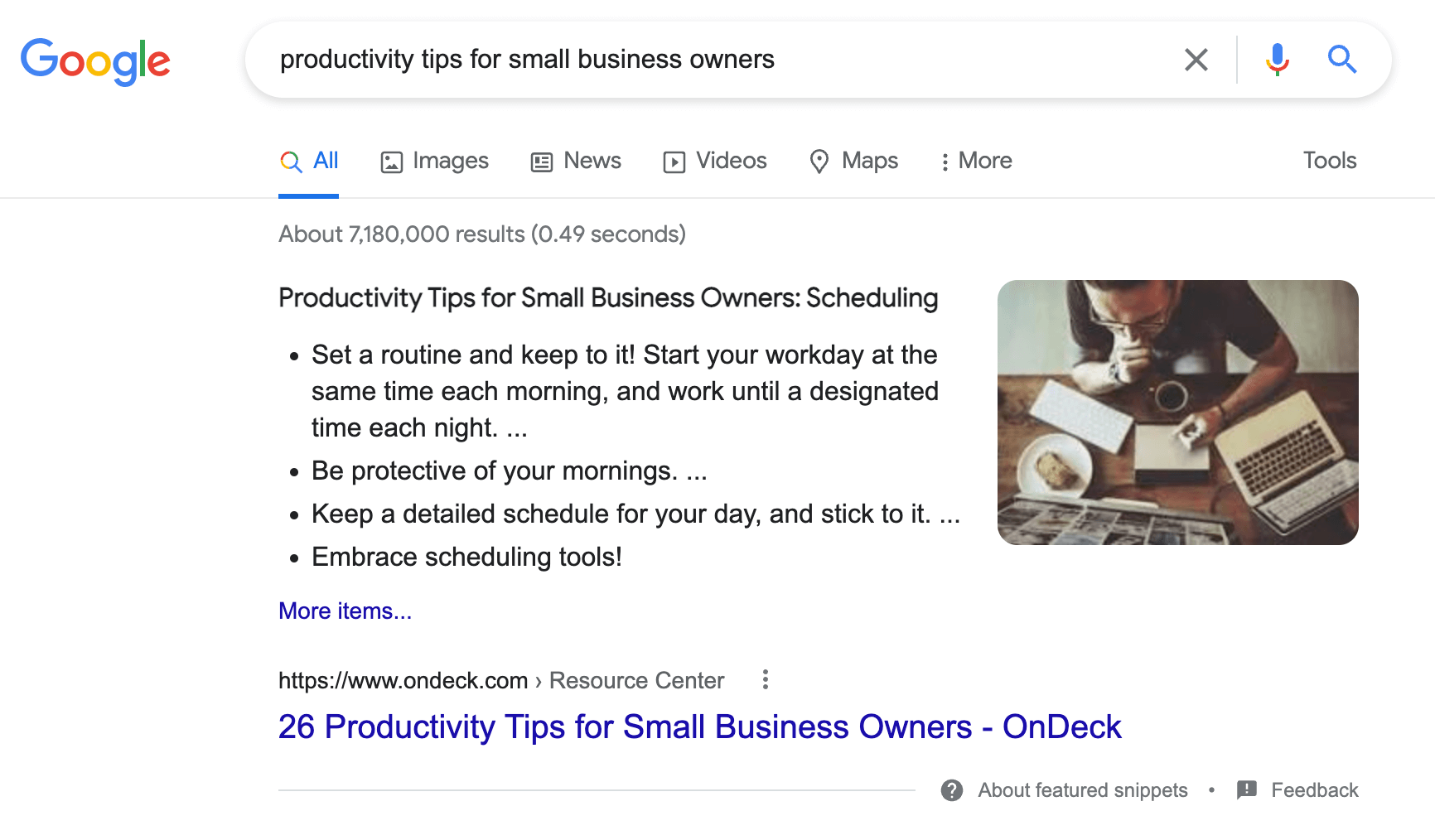
- Add a primary keyword to the opening paragraph and H2
A target keyword in your intro and H2 is one of the basic SEO principles. Using the keyword in the beginning makes your page relevant not only to the search engines but also to users.
However, make sure not to overdo it – use the main keyword in the intro once or twice maximum.
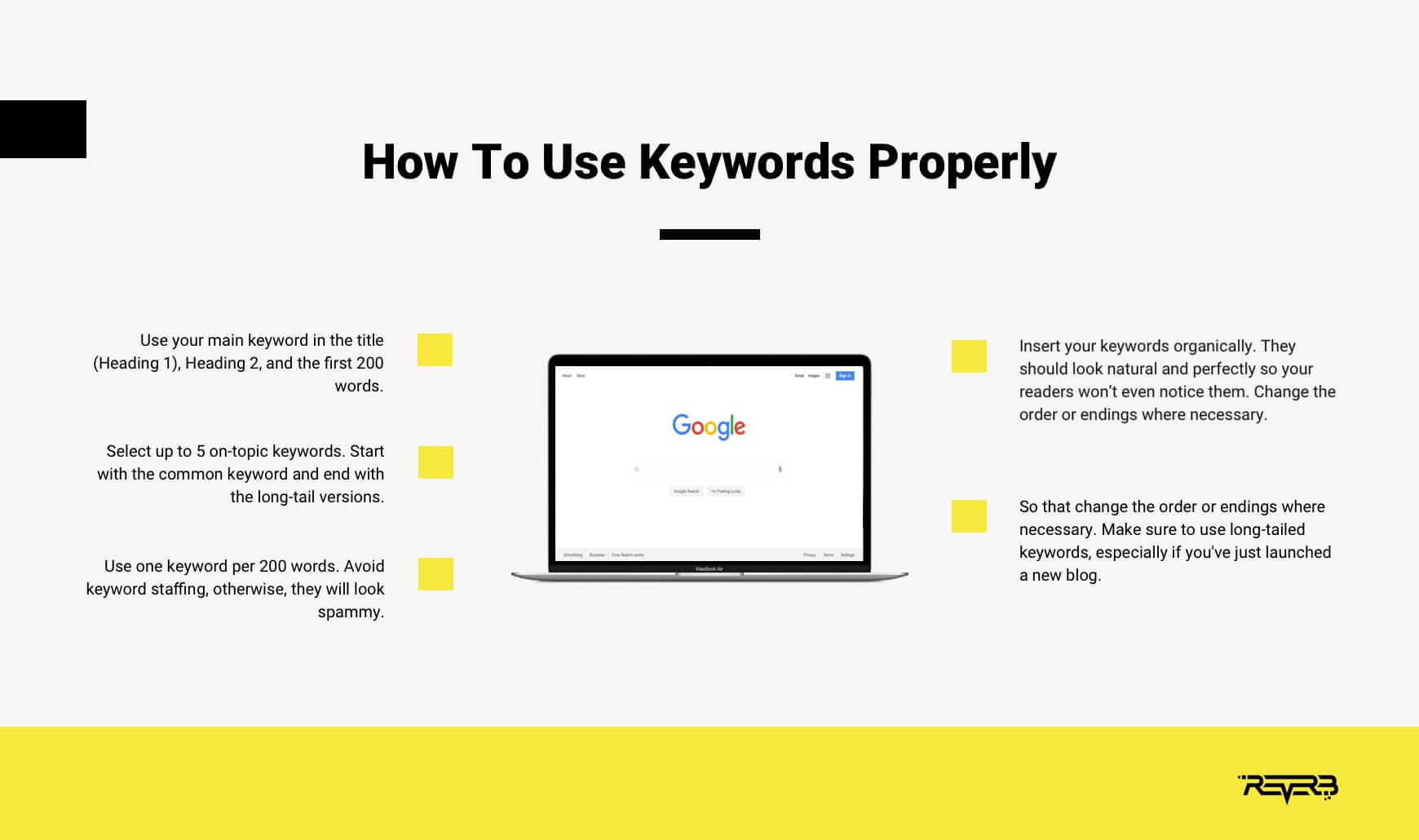
- Check your internal linking strategy
Internal link building is a simple yet fantastic way to create a better Google presence and a more immersive user experience.
When adding internal links, optimize your anchor text by writing a short but meaningful phrase that will make users want to learn more and click on it.
Including about 3-5 links to other authority websites in your article is important to show Google your content is trustworthy and well-referenced.
If you’re going through this checklist step by step, then by now, you should know it’s best to use a compression plugin.
In addition to this, here’s what you can do to optimize your images and help search engines better place your content:
- Name images descriptively.
- Optimize the image file size.
- Add alt text.
- Create unique custom images instead of using stock pictures.
5. Off-page SEO checklist
Publishing high-quality pages optimized with keywords isn’t enough to make your SEO work. To get high positions in search results, you’ll also need to put effort into off-page optimization, widely known as link building.
The idea is to get links to your pages from highly-authoritative websites. The more backlinks you have, the bigger your Domain Authority will be, and the higher positions your web pages will take in Google results.
So, drive your SEO to success with an off-page website optimization checklist that will help you set the rules for link building and improve your link building tactics.
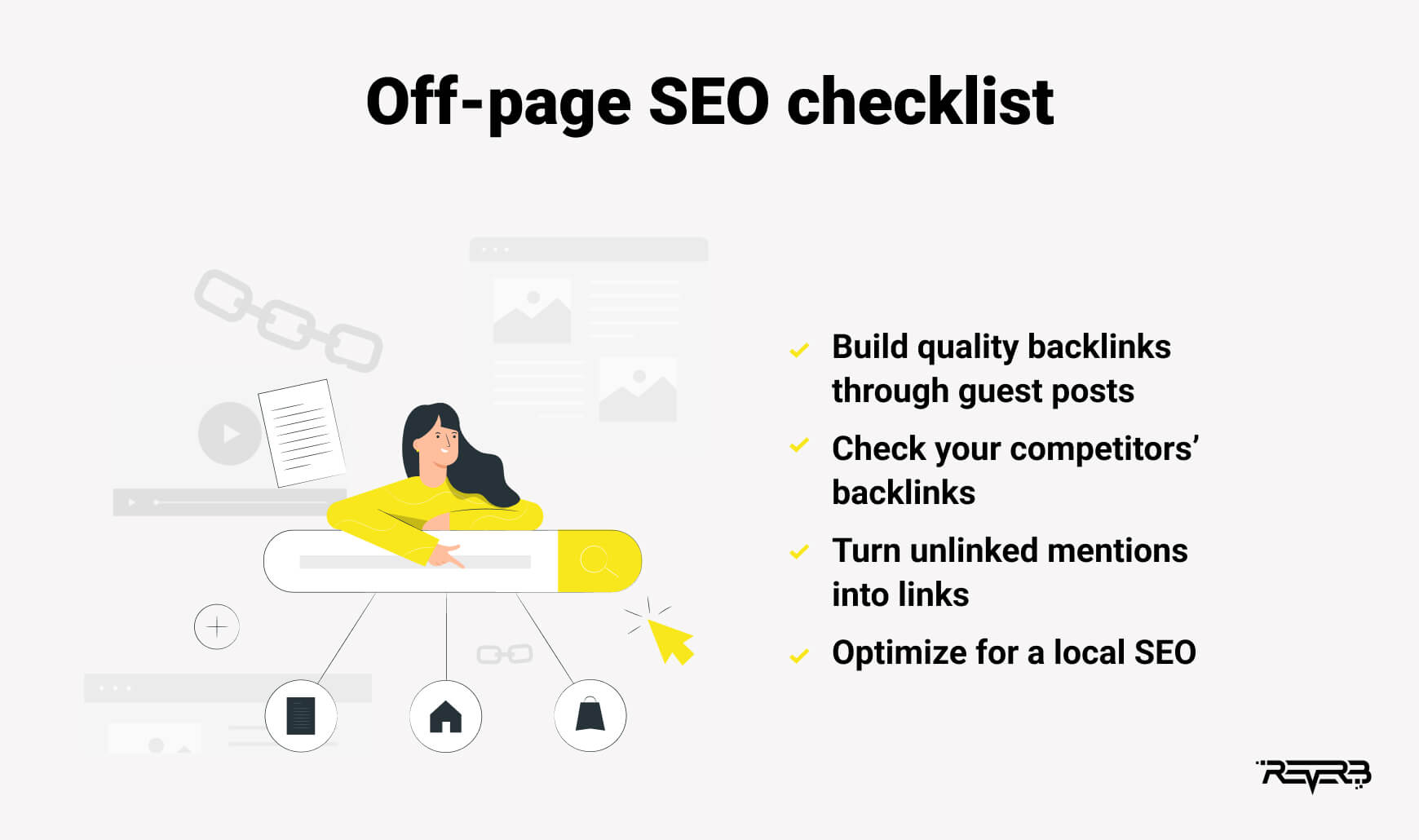
- Build quality backlinks through guest posts
Guest posts are a super-effective technique for your link building strategy. So, publishing a guest post on your industry’s trustworthy and respected website can bring you a valuable backlink and some referral traffic.
- Check your competitors’ backlinks
You don’t need to spend much time discovering new backlink opportunities. Instead, you can simply analyze your competitors’ links.
Ahrefs offers a great backlinks analysis tool that can help you see rivals’ backlinks and reach out to the same sites with a killer email.
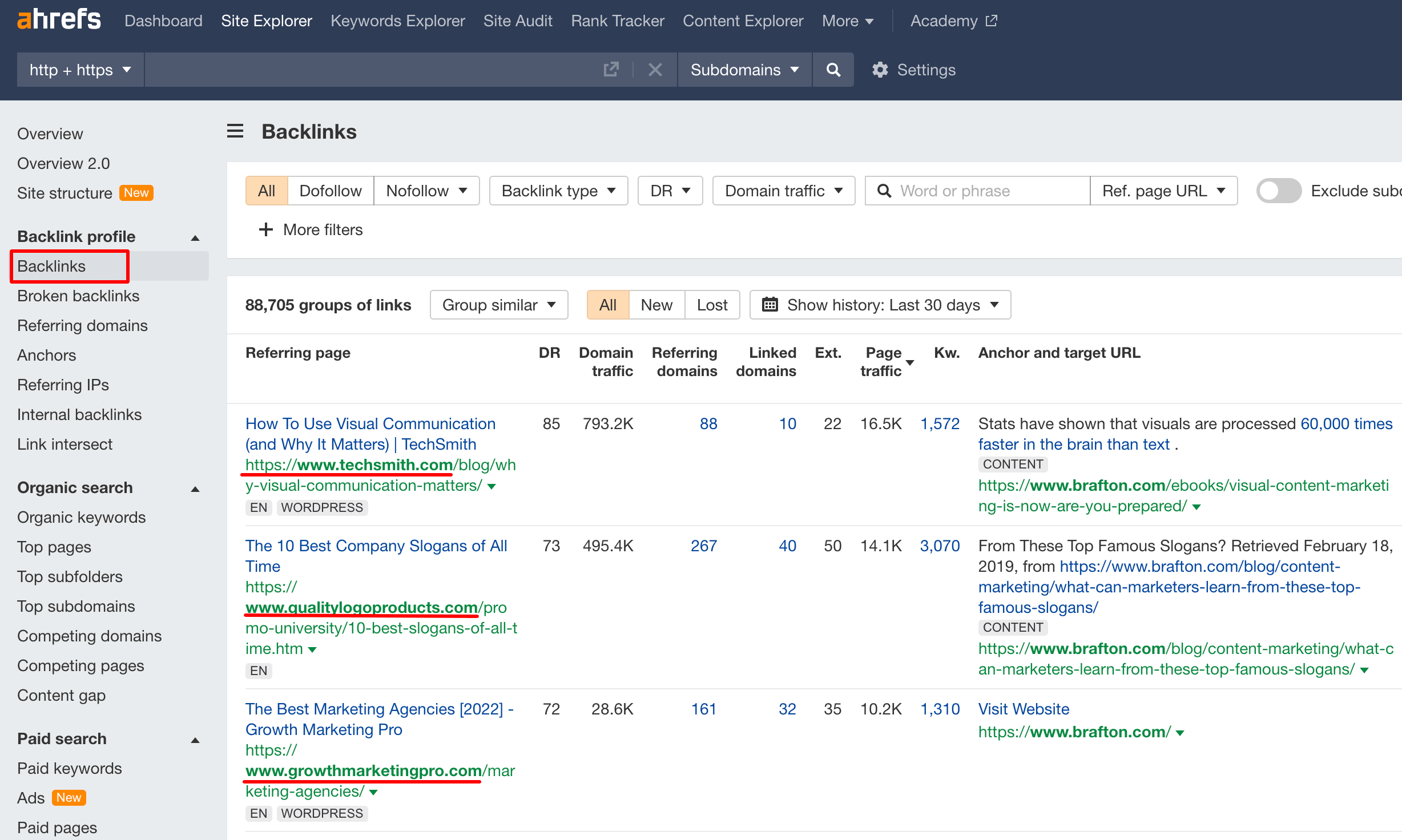
- Turn unlinked mentions into links
Most of the time, some articles will refer to your business without linking to it. The specialized Mention tool can help you identify those unlinked mentions, so you can ask for an author to include your link.
Local SEO helps optimize your website in the first positions of Google’s local searches. Ensure your business name, phone, address, work schedule, and website are consistent everywhere. Don’t forget to update it as soon as it changes.
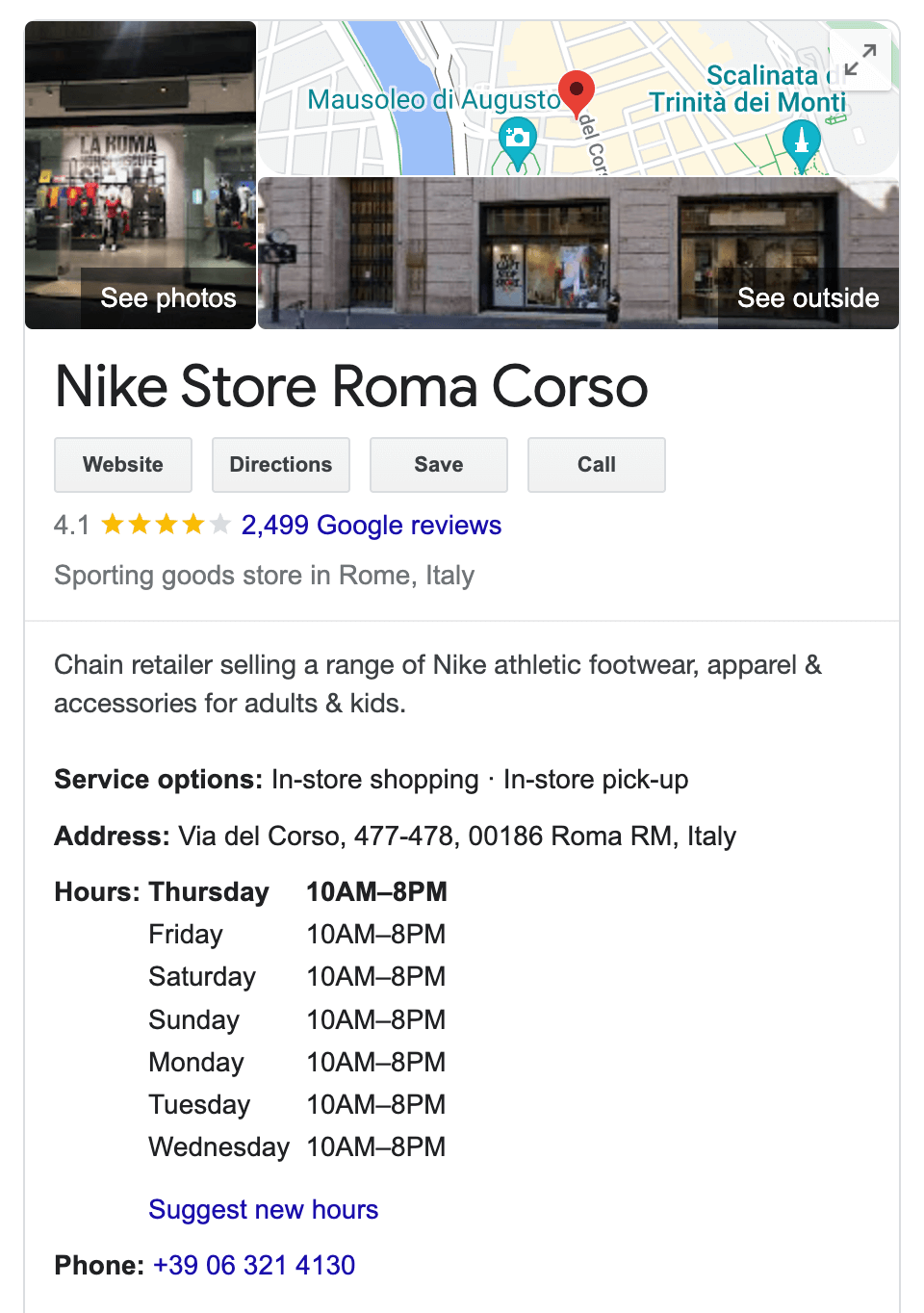
Conclusion
Fruitful search engine optimization is a difficult and non-stop process. However, it’s totally worth it if you want your web pages to be on top Google positions and attract hundreds to thousands of qualified visitors.
With the help of this ultimate search engine optimization checklist, you will be able to check your SEO presence twice as fast and make sure you don’t miss a single important step. You’ll see – your business will get ahead of your competitors in no time.
Don’t know where to start your successful SEO journey? Contact us today. ReVerb will help you develop a winning SEO strategy, from technical site audits and improvement to selecting quick-win keywords, creating top-notch content, and building strong backlinks.

























